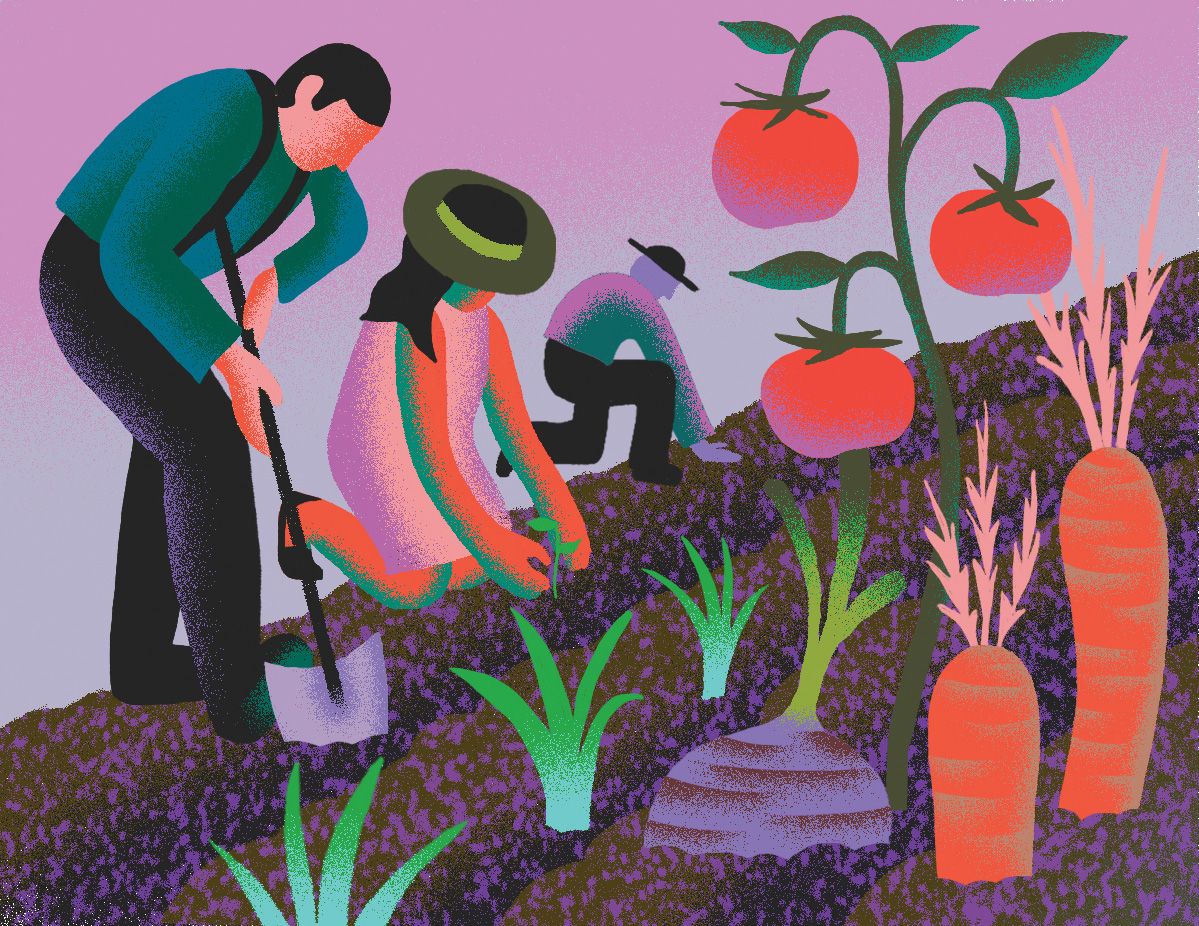As the pandemic smolders and the economy plunges into an abyss, Americans have reverted to the venerable World War II–era tradition of organized disaster gardening. According to headline writers, that is.
“Food Supply Anxiety Brings Back Victory Gardens,” declared the New York Times in late March. “Just like World War II, many are relying on their garden’s bounty to get them through this uncertain time,” echoed Good Housekeeping in early May. The multinational lawn-chemical giant Scotts Miracle-Gro wants to leverage this sentiment. “Plant your #VictoryGarden today,” a recent ad urges watchers over scenes of sun-dappled suburbanites pulling produce from loamy backyard plots.
Look around, though. Do you see vegetable gardens pretty much everywhere? Not just in private lawns, but also in vacant city lots, schoolyards, public parks, the strip between sidewalks and streets? That’s what Victory Gardens looked like, during World War II and also during World War I’s lesser-known gardening bonanza. These were giant mobilizations, harnessing grassroots energy with massive public investment.
What’s going on now is different. True, Google Trends reports that US searches for “gardens” have spiked this spring to their highest level ever, and vegetable seed sales are way up as well. Nearly 20 percent of adults surveyed in April said they had gardened more than usual in the past month. These data points suggest that millions of people are getting their hands dirty as food insecurity rises and government efforts to alleviate it sputter and our society enters an economic downturn that could rival or surpass the Great Depression.
But these aren’t Victory Gardens, any more than scattered individual refusals to pay rent constitute a general rent strike that challenges entrenched power. A true Victory Garden push would look like something else. It would channel the idled energy of mass unemployment away from despair and into something productive and hopeful, while also relieving stress and increasing access to high-quality fresh food. It would be unmistakably political, even radical. Scotts Miracle-Gro markets Victory Gardens as a self-affirming individual lifestyle choice. History offers a different model.

The Victory Gardens of World War II get all the ink, but they weren’t our country’s first attempt to garden our way out of a crisis. One notable experiment took place half a century earlier. After the Panic of 1893, Detroit was locked in the worst economic slump in its history, beset by unemployment and covered in abandoned lots. Surveying the ruins of a boom gone bust, Mayor Hazen Pingree envisioned a blooming city. His “potato patch” program allotted vacant land to families for growing food.
City elites scoffed at the plan to devote land in a budding modern metropolis to the grubby, backwater activity of food production. But the city’s idled, hungry working class—a quarter of it comprising recent immigrants from Central Europe, including many displaced peasant farmers—rallied behind Pingree’s vision. A blighted landscape turned green and bountiful, alleviating hunger. By 1896, 1,700 Detroit families managed gardens covering more than 400 acres. The “Detroit Plan,” as it became known, soon took root in similarly devastated metropolises like New York City and Philadelphia. Now largely forgotten, Pingree’s initiative established a pattern that has held ever since: When the going gets tough, Americans turn to gardening for comfort and sustenance.
The first great national gardening mobilization came two decades later, scholar Rose Hayden-Smith writes in her 2014 book Sowing the Seeds of Victory: American Gardening Programs of World War 1. Building on a Progressive Era push to install gardens in public school yards as an educational tool, President Woodrow Wilson tapped the Bureau of Education, with funding from the War Department, to launch the US School Garden Army shortly after sending troops to intervene in the European conflict. “A Garden for Every Child,” its slogan promised. “Every Child in a Garden.”
The School Garden Army was just one of several national programs that “encouraged Americans to express their patriotism by producing and conserving food,” Hayden-Smith adds. Wilson also promoted a civic gardening boom through the Committee on Public Information, which hired writers, artists, scholars, and advertising professionals to create marketing campaigns to promote school, home, and community gardening.
A government-employed cadre of writers, artists, scholars, and advertising professionals pitched gardening as military cosplay. “Youth gardeners were recast as ‘soldiers of the soil,’ and no plot was left uncultivated, lest it be considered ‘slacker’ land,” Hayden-Smith writes. “Gardens were ‘munitions plants,’ garden furrows became ‘trenches,’ and food was referred to as ‘ammunition.’” As a result, she writes, while war raged abroad, a children’s brigade mobilized across the country to cultivate the homefront, in rural and urban areas alike. In Los Angeles alone, thousands of students grew produce in 13,000 school gardens. In Santa Monica, war gardeners tilled the ground between sidewalks and roads, treating residents “to the sight of tall cornstalks or meandering vines of the pumpkin or watermelon variety in the place of the neat grass plots that heretofore adorned the strips,” the Los Angeles Times reported.
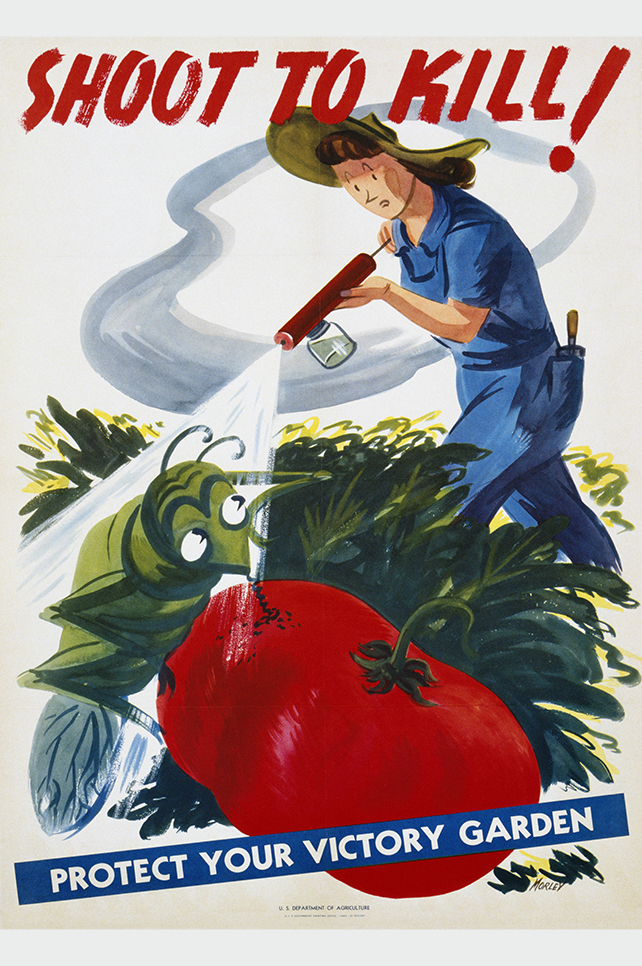
Swim Ink 2, LLC/CORBIS/Corbis via Getty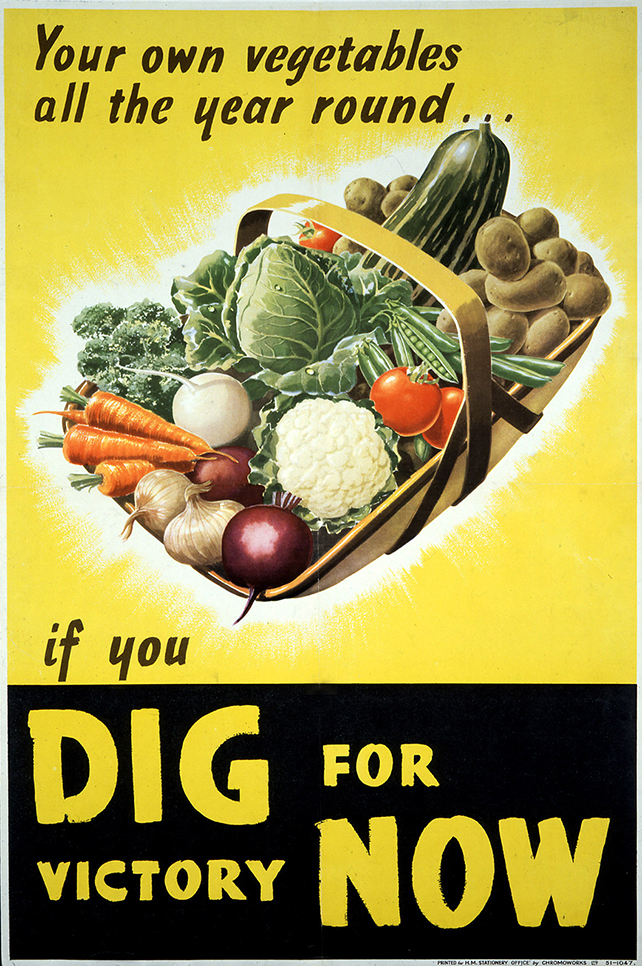
In a 1919 pamphlet, the National War Garden Commission employed apocalyptic rhetoric to try to sustain the garden frenzy into the postwar era. “Prevention of widespread starvation is the peace-time obligation of the United States,” the pamphlet declared. The alternative: “Europe’s immolation in a conflagration of anarchy such as Russia is plunged in today,” a reference to the 1917 Bolshevik revolution. The nation’s farmland had already maxed out its capacity, the pamphlet argued. “It is obvious, therefore, that if we are to give the world more food,” the “only source” could be “small gardens in our urban and suburban communities.”
Even so, the garden boom waned after the Armistice, as bumper US farm harvests and the revival of European agriculture pushed down food prices. But it created fertile ground for the Victory Gardens of the World War II era. Informed by garden tips in newspapers and radio broadcasts and aided by a federal ad campaign, Americans (many of whom worked in World War I gardens as kids) transformed backyards, vacant lots, playgrounds, company grounds, schools, and parks, writes Laura Lawson, a professor of landscape architecture at Rutgers, in her book City Bountiful: A Century of Community Gardening in America.
Municipal governments put their weight behind the effort. In San Francisco, Lawson notes, local leaders drafted prime public spaces for the cause. Union Square and the lawn outside the Civic Center sprouted large demonstration gardens, and sections of Golden Gate Park were handed over to gardeners “on a first-come” basis. In 1943, she writes, a “Victory Garden Fair” in the park drew thousands of people, “with exhibits, entertainment, and experts to provide advice.” In Washington, DC, city leaders cobbled together 650 acres of land, including swaths of Rock Creek Park—some public, some temporarily donated by private owners—to offer as plots in early 1943. By March, Lawson reports, the city had received 35,000 applications from residents.
National political leaders got in on the fun. In 1943, Vice President Henry Wallace—a former national agriculture secretary from an Iowa farm family—posed for a newspaper photo beside an 11-foot-tall corn plant. Three generals and a US senator obtained plots at a garden in one of DC’s toniest districts, with plans to “get a bit of exercise and get away from the war by chopping away at weeds during the late daylight hours of this spring and summer,” a local newspaper reported in early 1943, Lawson notes. That same year, first lady Eleanor Roosevelt did her bit, turning over a patch of the White House lawn to adolescent gardener Diana Hopkins, daughter of presidential adviser Harry Hopkins.
Lawson says it’s virtually impossible to attach a dollar amount to the federal government’s support of the garden boom, because “so much of it was in-kind—administrative aid, experts giving advice, lent sites and equipment.” Victory Gardens were the virtuous result of a pent-up energy to do something, anything, at home during an all-consuming overseas conflagration. The success was staggering. In 1944, a Gallup poll found that 59 percent of respondents reported having a vegetable garden—a 50 percent jump from prewar levels. By 1944, Lawson reports, government data suggested that between 18 and 20 million families had caught the Victory Garden bug, collectively churning out 40 percent of the country’s vegetable supply.
And the gardens provided more than just ample fresh food. At a time of enormous anxiety over a brutal war—with 16 million Americans in uniform—Victory Gardens gave civilians on the home front the opportunity to “do something tangible and productive,” Lawson says. “You’re providing fresh food for your family, you’re spending time with your kids in the garden. There were lots of therapeutic and patriotic reasons for doing it, too.”
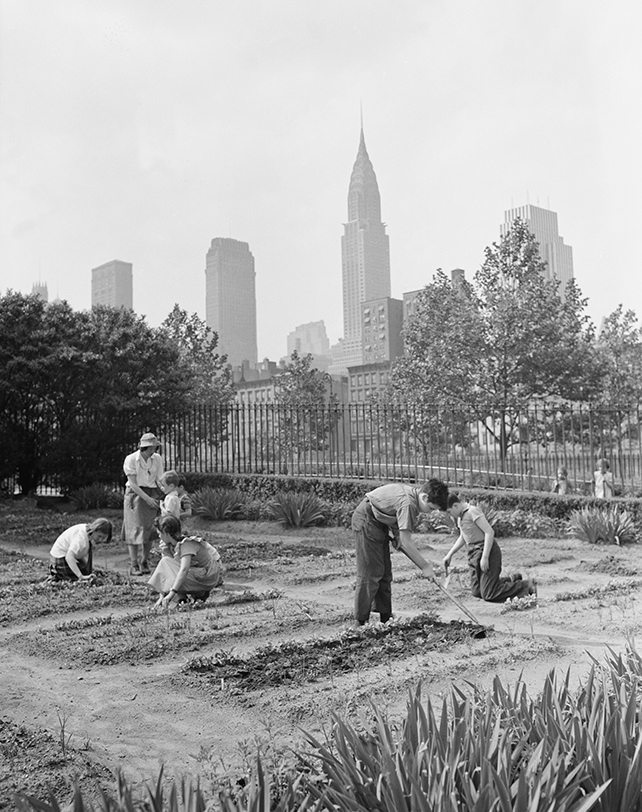
Universal History Archive/Getty
In the decades after those gardening booms, we’ve seen a few mini-revivals: As rising environmental consciousness met a shrinking economy in the 1970s, I remember my mother stretching pricey beef with Hamburger Helper and venturing a backyard veggie patch, complete with a festering compost heap. After the financial meltdown of 2008, amid a jump in food prices, the chair of the venerable W. Atlee Burpee seed company told the New York Times that seed sales had spiked 40 percent, adding: “You don’t see this kind of thing but once in a career.” In 2009, incoming first lady Michele Obama fortified the trend by plowing up part of the White House lawn for a food patch.
But recent history tells us that any promising shoots of a mass gardening revival typically level off when the economy recovers. Meanwhile, pockets of the country that have been in crisis for decades have seen under-the-radar gardening efforts flourish without much media attention. They point a way forward to a greener, more resilient post-pandemic future.

If you look at the US economy as a whole, the post-1970s era has been marked by steady economic growth, interrupted by relatively minor recessions until the great one of 2007–2009. So it’s not surprising that, despite periodic headlines heralding the return of Victory Gardens, household and community vegetable production has never actually approached World War II levels. The urge to get one’s hands dirty growing food has a tendency to wane in a robust economy powered by cheap consumer goods, including fast food.
But national economic growth rates cloak massive inequality across regions. Some places never fully participated in the various booms of the past half century. For them, the economic malaise of the 1970s never fully lifted. In many of these left-out areas, even densely urban ones, community-scale vegetable gardening did persevere—mainly without media hype.
As the national economy hurtles toward a cliff, it’s worth taking a fresh look at what made community gardens sprout in recent decades in the Bronx in New York City, Northern California’s Richmond, and Detroit—areas populated largely by low-income people of color and surrounded by massive wealth. The struggles of these cities offer a taste of the economic trouble that may be coming our way, and their gardening efforts deliver an example of how to stay resilient in tough times. They teach us that, in a crisis, out of some combination of individual initiative and government support, a robust collective gardening infrastructure can take shape and yield more than just (much-needed) food. Right now, at the national scale, we’re missing just one of those key ingredients.
The backstory goes like this. In the 1960s, especially in the North, the postwar urban manufacturing base began to melt away. Millions of white families (and their tax dollars) fled to the grassy expanses of suburbia, leaving a hollowed-out urban core to largely African American and later immigrant populations. Inner-city rents fell, and many landlords suddenly owed more in property taxes than they were making in rent, leading them to hand properties over to municipal ownership in exchange for delinquent taxes.
It was from this prolonged period of urban disinvestment and blight that the modern-day community garden movement sprang. In these zones, residents got busy cleaning up newly vacant lots and spreading topsoil and seeds. Again, the federal government got involved. In 1977, the Department of Agriculture rolled out the Urban Gardening Program, which dispatched agricultural extension agents—usually tasked with helping farmers to adopt new technology—to help low-income urban residents grow food. The program was a success. By 1989, Urban Gardening Program staffers and volunteers were working “with 200,000 low-income urban gardeners, producing $22.8 million worth of produce on a budget of $3.5 million,” reports the urban-agriculture scholar Kristin Reynolds. Even so, the program was shuttered in 1994, a victim of that era’s fiscal austerity.
Municipal governments and nongovernmental organizations stepped up in some places. In Detroit, Mayor Coleman Young launched the Farm-a-Lot Program in 1975, designed to link the city’s largely African American population—struggling under the twin burdens of rampant unemployment and galloping food prices—with unused land as well as technical gardening assistance. In New York City, the government often leased the city’s swelling stock of unused lots—which it had acquired in seizures over unpaid property taxes—to community gardeners for $1 annually, provided they volunteer the labor to clean out rubble and debris. Robust community garden movements with roots in the era remain in both cities.
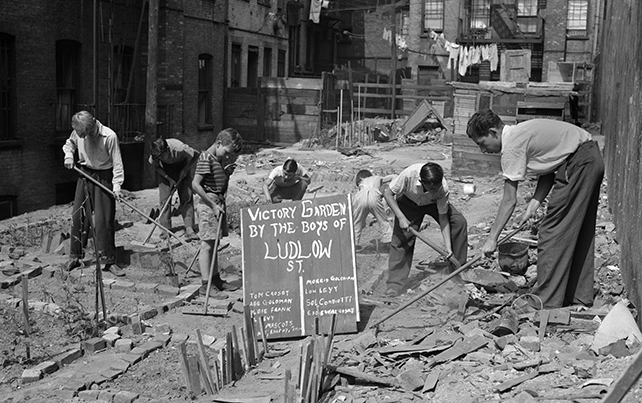
Charles Phelps Cushing/ClassicStock/Getty
In the 1980s, New York’s outer boroughs had high unemployment and a dearth of basic city services. Karen Washington was starting a career as a physical therapist when she moved into a new place in the Bronx in 1985. Across the street was a lot that had been slated for a new apartment building. But before construction started, the developer abandoned the project, leaving the ground bare. It quickly became a magnet for “garbage, abandoned cars, prostitution, drug activity, you name it,” Washington recalls.
Then one day, in 1988, “I happened to look on my kitchen window and I see a guy across the street with a shovel and a pick,” she says. She went out to ask him what he was doing. “He says, ‘I’m thinking about doing a community garden.’ And I said, ‘can I help?’”
The New York Botanical Garden had just launched a program called the Bronx Green-Up, to help interested residents take over abandoned spaces for gardens. From this confluence of grassroots initiative and institutional backing, the Garden of Happiness was born.
Washington and her fellow Bronx gardeners weren’t called to garden in order to grow food—at least not at first. Residents felt stigmatized for living in a low-income area. “I remember people saying that we were animals, that we live in filth,” she says. “So when people got together, we started planting flowers and trees and perennials to make the gardens look beautiful.” The greenery changed “how people looked at their neighborhood.” Later, when Black transplants from the US South and the Caribbean and later waves of immigrants from all over Latin America moved in and brought with them farming know-how, food production became the garden’s focus.
The Garden of Happiness thrives to this day; 20 families now have plots there. On the April morning I talked to her, Washington had to cut off our call so she could run across the street to feed the garden’s laying hens.
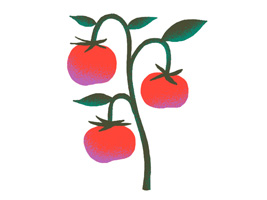
Like the Bronx, Richmond, California, a port city of roughly 100,000 residents just north of Berkeley, is a low-income pocket of one of the globe’s wealthiest regions. Third-generation resident Doria Robinson runs Urban Tilth, an urban agriculture juggernaut with two youth-training programs, a fruit-tree orchard, several community gardens, and two farms that provide weekly food boxes to its 227 CSA member families. “We serve low-income communities of color, and we ourselves are low-income members of this community,” she says.
While neighboring Berkeley boasts a world-renowned university and restaurant scene, Richmond is where the Bay Area has chosen to park perhaps its dirtiest operation of all: a Chevron oil refinery that processes 245,000 barrels of oil per day. Robinson grew up in Richmond’s flatlands, five blocks from the refinery, an area occupied “primarily by Black and Brown people—low-income, not a lot of access to political power,” as she puts it. And in sharp contrast to Berkeley’s farm-to-table cornucopia directly to the south, Richmond has “one grocery store for 100,000 people, lots of corner stores, fast-food restaurants, a plethora of junk food, and very few places to buy fruits or vegetables that you’d actually want to eat,” Robinson says.
Hear from Urban Tilth’s Doria Robinson on this episode of Bite.
In the early 2000s, Robinson was working in ecological restoration in the East Bay when she got an email from local activist Park Guthrie about an idea: He wanted to reclaim a long-abandoned railroad path. It had already been restyled as a park called the Richmond Greenway, but it really served as a kind of no-man’s-land dividing line between gang territories, “full of trash and prostitution,” she says. The vision was to till up a two-mile stretch of the greenway for community gardens. Guthrie launched Urban Tilth to manage the transformation, and Robinson joined volunteer efforts to transform the blighted stretch.
Today, it’s a 23-block-long park with seven community gardens, playgrounds, and an orchard with 84 fruit trees. The experience convinced Robinson that Richmond’s abandoned industrial spaces could be the assets—“with willpower, we could actually transform these spaces into places that feed the community instead of kind of drain the community.”
Urban Tilth’s success could never have happened if local residents like Robinson hadn’t pitched in their labor, but such effort by itself isn’t enough: They also needed long-term access to land. A scrappy nonprofit would have been hard-pressed to come up with the cash to buy three acres of farmable land for North Richmond Farm, Urban Tilth’s main food-production space. And even if it could get a loan to buy it, it would tough to make enough money selling vegetables to pay it off. Fortunately, a Contra Costa County board of supervisors member and Richmond native, John Gioia, had the idea to try an urban farm after seeing a thriving example of one on a visit to Oregon. He found an unused county-owned lot, and the county ultimately leased it at low cost to Urban Tilth, which quickly brought it to life with vegetables.
Once an operation like North Richmond Farm is up and running, it can churn out loads of food and generate enough income to pay employees without outside support, Robinson says. “But the margins are just too small” to finance land purchases and other infrastructure, like a facility to pack and clean vegetables, or a van to distribute them. Yet once those investments are made—whether by governments or foundations—the payoffs are significant. Robinson calls the stuff that makes urban agriculture work, like land and packing sheds, “health-producing infrastructure.” “Cities should think about people’s health as an asset just in terms of the bottom line—you’re going to have a lot less people using emergency rooms” and other health care services. Recent research supports Robinson’s assertions. Some urban areas with higher concentrations of green space, including community gardens, have reported lower crime rates and improved health metrics like death rate from cardiovascular and respiratory problems.
And when a crisis like COVID-19 hits, such places are more resilient, the Richmond example suggests. Not long after California shut down its economy in March, a county official called Urban Tilth to say “you guys are essential services, you keep going, don’t stop the CSA,” Robinson says. “We realized that we’ve basically been preparing for that moment, and we were ready to hit the ground.” The group continued planting, harvesting, and delivering food to more than 200 families, many of which had vulnerable members, “helping them feel safe, fed, and connected to other people.” Urban Tilth’s CSA is currently maxed out; its waiting list has spiked since the onset of coronavirus, and now stands at more than 270 families. All that’s holding back expansion, Robinson says, is access to more land.

Detroit emerged as an industrial colossus for just long enough to draw a large migration of African Americans from the South, and then crashed—abandoned first by car factories and then by the great majority of its white residents. The city’s population peaked at more than 1.8 million in 1950. Today it stands at 670,00—and its tax base and city services have withered accordingly.
And the potato patches are back. The city has what is almost certainly the nation’s most extensive network of inner-city food production plots: 1,589 vegetable gardens and farms, engaging more than 25,000 Detroiters, according to nonprofit Keep Growing Detroit.
Malik Yakini is a co-founder of the Detroit Black Community Food Security Network, which runs D-Town Farm, a four-acre vegetable plot in Detroit. Yakini, a lifetime Detroiter, reported the COVID-19 crisis had cast a terrifying shadow over his community—a hot spot for a virus that has proven to be particularly deadly for Black people. It delayed spring planting at D-Town, depriving the community of a source of fresh food at a time of growing need, and postponed the launch of Detroit People’s Food Co-op, a grocery store meant to connect the city’s low- and moderate-income residents with quality produce grown nearby.
At the same time, the crisis has sparked another surge of interest in growing food. “We’re encouraging people to do backyard gardens, container gardens, side-lot gardens—and we’re giving away packets of seeds to help facilitate that process,” he says. And the interest is enormous. “I’ve had more people contact me in the last month about getting a garden started or participating in our food co-op than I have had contact me in the last five years.” Yakini says the city, with its thousands of vacant lots, needs to make it easier for residents to get long-term access to land currently sitting idle.
On a national level, if urban agriculture is going to thrive, he argues, it needs “infusions of cash”—like the kind conventional agriculture receives. Today’s big farms owe their existence to the 19th-century Homestead Act, through which the US government seized prime land from American Indians and doled it out to white settlers, Yakini pointed out. We now prop up these commercial farms with billions of dollars of annual subsidies. On top of usual annual subsidies of several billion dollars, these operations got a staggering $28 billion in special targeted relief from President Trump to compensate them for his trade wars, and will likely grab the great bulk of a recently announced $16 billion COVID-19 relief fund for agriculture.
The grassroots energy to support urban food projects is there, Yakini says. What’s missing is the public investment to nurture these efforts into a bumper crop of collective gardening activity that can help us endure the COVID-19 cataclysm.
The USDA could revive—and properly fund—the defunct Urban Gardening Program, which could help cities identify arable land and dispatch extension agents to help manage the transition to productive community gardening. Successful existing projects like Urban Tilth, D-Town Farm, and many others across the country could be given grants to expand operations and bring more land under production. School garden programs, like Berkeley’s Edible Schoolyard, could be federally funded and made part of a universal curriculum. If the federal government wanted to bring about an actual—not just a headline writer’s—revival of Victory Gardens, it could also look into its own World War I– and II–era archives for ideas. Such a move might not be as fanciful as it sounds. While running for the Democratic presidential nomination in 2020, Bernie Sanders proposed a “victory lawns and gardens initiative,” involving a 10-year, $36 billion investment to “help urban, rural, and suburban Americans transform their lawns into food-producing or reforested spaces that sequester carbon and save water.”
While presumptive nominee Joe Biden based his pre-COVID-19 campaign on quashing such bold ideas, he has since changed his tune and is now calling for New Deal–style programs to revive the pandemic-stunned economy. A President Biden could reprise the New Deal’s Civilian Conservation Corps, a public work-relief program that among its tasks could pay unemployed people to engage in food relief through gardening.
At the moment, the economic privation felt for decades in hollowed-out postindustrial US cities is looking more like the norm than the exception. In a sense, we are all Detroit and Richmond and the Bronx now—tens of millions more Americans are struggling to put food on the table amid a jobs crunch that could extend well into the next decade. Gardening can never replace the global food supply chain that has built up over the past century, but it can make communities more resilient to disasters. The spring’s boom in seed sales showed that lots of people are ready to get to work in the dirt. What’s missing is the other key ingredient: a big push from the government.
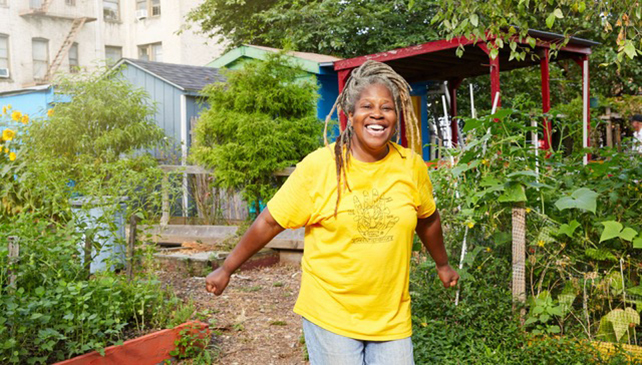
Courtesy Karen Washington
When I spoke to Karen Washington last month, the Bronx had emerged as a global hot spot for COVID-19. Her daily work tending vegetables in the garden’s high tunnel and prepping beds for the upcoming season felt more important than ever, she said. The news was full of images of how the lockdown had led to suddenly crystal-clear air in polluted areas of Italy and California. “Air and water is clearing up, and animals are less fearful about coming out,” she said. “So, for me, this is a wakeup call: What direction do we go? Do we continue to a self-centered way of living? Or do we step back and pause for a second and look at how we should be living: caring for the environment, relying on each other, working in community?”
